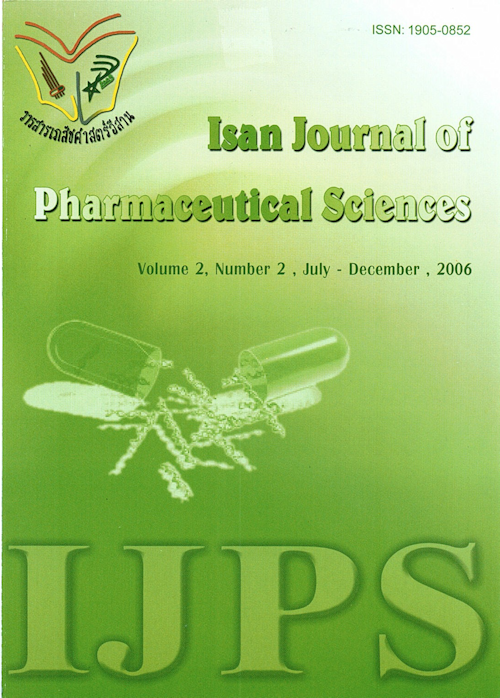Self-reporting Multidimensional Work Sampling of Pharmacists in Inpatient Care ActivitiesKhaoeong HospitalKalasin Province
Main Article Content
Abstract
Self-reported multidimensional work sampling (MDWS) was used to determine the amount of time that pharmacists spent in in-patient care services at Khaowong Hospital. The in-patient pharmacists were signaled 5 times per hour at random intervals during the working time by random reminder equipment. Following these signaling, pharmacists recorded their works in four dimensions: activities, contact, function and location. The data were collected over the three-month period from December 2005 to February 2006 during the working hour (at 8.30-12.00 and 13.00-16.30).
The number of recorded observations were 2,866. For the activity dimension, in-patient pharmacists spent most of their time on drug preparation and distribution (83.3% of working time). They spent 6.1%, 2.9%, 4.3%, and 2.9% on administrative activities, clinical pharmacy activities, delay activities, and personal activities, respectively. Considering the contact dimension, the in-patient pharmacists spent a large proportion of working time with themselves (73.1%). They spent 20.9% of working time with patients and patients’ family, and 6.0% with other health care staff (physician, nurse, pharmacist, and other personnel). Regarding to the location dimension, pharmacists spent 55.4% of working time at pharmacy stations, 25.4% at nursing station, 13.3% at patient-care areas, 1.2% at meeting rooms, and 4.6% at other locations (library, information center room, quality administrative room, and general administrative department room). Data for the function dimension indicated that the in-patient pharmacists spent the most of working time for five purposes as follows: preparing prescriptions (22.2%), preparing labels (22.0%), dispensing prescriptions (19.7%), doing patients’ drug profiles (14.9%), and reporting (4.3%).
The information generated by self-reported work sampling can be used in decision making that affects pharmacy operations for work improvement. This study showed that the in-patient pharmacists spent a little of their time on clinical pharmacy activities (<3% of working time), while they spent most of their time on drug preparation and distribution (>83% of working time). To facilitate patient-oriented care services, the time used in clinical pharmacy activities should be increased in the in-patient pharmacists’ role.
Article Details
In the case that some parts are used by others The author must Confirm that obtaining permission to use some of the original authors. And must attach evidence That the permission has been included
References
Beech EF and Barber ND. (1993).The Development of a self-reporting Multidimensional Work Sampling Measure to Study Ward Pharmacy Services in the United Kingdom. Journal of Social and Administrative Pharmacy, 10(4), pp. 157-162.
Heizer J and Render B. (2004) Operations Management. New Jersey: Prentice Hall.
Nickman NA, Guerrero RM, Bair JN. (1990). Self-reporting work-sampling methods for evaluating pharmaceutical services, 47(7), pp.1611-1617.
Rascati KL, Kimberlin CL, McCormick WC. (1986). Work measurement in pharmacy research. American Journal of Hospital Pharma, 43, pp.2445-2453.
Ried LD, West TE, Martin P, Force พ. (1991) Multidimensional work sampling to study the activities of decentralized clinical pharmacists. American Journal of Hospital Pharmacy. Jun, 48(6), pp.1211-9.


